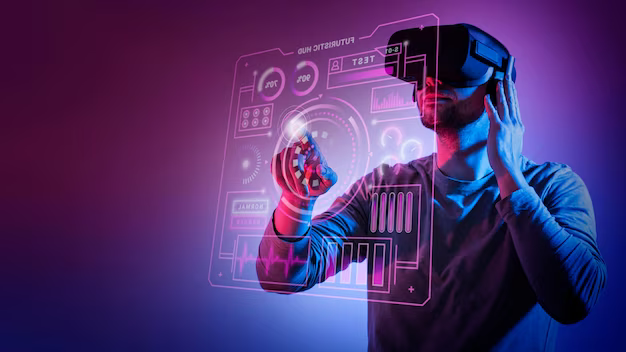Blockchain Development: Building the Future of Decentralized Systems
Blockchain technology has emerged as one of the leading technologies in recent times, which is poised to change multiple industries. The technology is a distributed ledger that securely stores transactions over networks of computers. It has the capability of dismantling several industries such as Finance, health care, and supply chain management. Immutability is a feature that blockchain technology delivers as part of the chain of records or blocks. The files, transactions, and related data are contained in blocks used to make up the blockchain.
Businessman using a computer to Blockchain technology concept with a chain of encrypted blocks to secure cryptocurrencies and bitcoin for online payments and money transaction
Additionally, the blocks are connected with hashes. The technology is widely known for backing up cryptocurrencies such as Bitcoin, Ethereum, and Litecoin. However; with the inevitable advancement of technology, several use cases have come to rise such as NFTs and DAOs.
Understanding Blockchain Programming
Data scientists. Male programmer using laptop analyzing and developing in various information on futuristic virtual interface screen. Algorithm. marketing and deep learning of artificial intelligence
Blockchain programming plays a crucial role in blockchain development, writing smart contracts and deploying them on the chains. It involves an in-depth knowledge of the principles on which blockchain operates and specialized programming languages. Here are some detailed insights into blockchain programming:
OOP on Blockchain
In the case of blockchain programming, OOP is often used as an idea. OOP is an object-oriented programming paradigm where objects and classes are used to design as well as develop applications. Under the umbrella of blockchain, OOP is used to write smart contracts and describe how applications are written for a blockchain-based environment work
Smart Contracts and Blockchain Programming
Smart contracts are the foundations of blockchain programming. These are self-performing contracts that have the terms of the agreement coded in. The use of smart contracts simplifies transaction processing by removing intermediates and automating transactions based on preset conditions. They’re normally written in dedicated programming languages like Solidity – purpose-built for Ethereum
Programming Languages for Blockchain Development
Different programming languages are widely applied for blockchain development – Solidity, JavaScript, Python, C++, and so on. Every language has its strengths and is used in various facets of blockchain development. For instance, Solidity is popular for coding smart contracts while JavaScript programs dApps which are run on blockchain networks
Blockchain Programming Tools and Environments
Blockchain programmers can use IDEs to compile, test, and run blockchain software. The notable IDEs for blockchain development include Hardhat, Truffle, and Remix. Moreover, front-end environments like Node.js are employed to build the graphical and user interface aspects of decentralized applications. It is also necessary to possess APIs that are available for developers so that they can investigate blockchain data and transactions.
Learning Blockchain Programming
Therefore as a basic foundation for people who want to learn blockchain programming, the technology first needs to be understood. Knowledge of popular blockchain platforms, such as Ethereum and Bitcoin is also necessary. Moreover, mastering programming languages such as the Solidity language and JavaScript also plays an important role in becoming a skilled blockchain programmer.
Smart Contracts
Creative abstract blockchain technology sketch on modern laptop background, future technology and blockchain concept. Double exposure
Smart contracts are self-executing agreements that operate on distributed ledger technology to implement transactions between two parties. The base for dApps is encoded and saved on the blockchain protocol, which is irreversible but safe.
Key features of smart contracts include
Automation: With smart contracts, the need for intermediaries disappears because agreements between parties automatically occur cost-effectively.
Immutability: Due to this, contracts based on blockchain structure are not changeable and cannot be fooled because the conditions of that contract will always take precedence.
Decentralization: Third-party interference is minimized and hence transparency is enhanced by the use of smart contracts on distributed blockchain networks.
Versatility: Smart contracts are not limited to conditional sentences, and are utilized in other areas such as supply chain management and real estate transactions voting system.
Smart contracts have numerous advantages, including speediness efficiency reliability trustworthiness transparency safety, and cost-savings. They can also alter the business model or interactions, and that is why they are so central to Blockchain Technology Works.
Decentralized Applications (dApps)
Decentralized Application Dapps concept. Blockchain technology fintech Open-source software and Smart Contract concept on ethereum cryptocurrency. isometric flat vector icon
A digital application or program that works using a decentralized network of computers, including but not limited to blockchain and p2p networks is dApps. In contrast to applications that are centrally applied on servers owned by one single entity, dApps do not have an owner and run in a decentralized manner without the need for any human interference.
The features of dApps include development with the use of blockchain technology and cryptocurrency as a medium for exchange. They are usually developed on top of Ethereum and have uses in gaming, finance, social media platforms, etc. Examples of dApps include Peepeth, a social network alternative to Twitter analogue; Cryptokitties – a game and MakerDAO which is a decentralized credit service supporting Dai that allows users to lend V collateral.
For an application to be considered a dApp, some conditions must apply such as open source, decentralized, and incentives. The dApp codebase must be in the public domain and modifications to its structure or operation should only occur with community consensus. All dApps should be decentralized because the information and operations are kept on a blockchain network that is public for all people to see. They should also provide incentives to their users in the form of cryptographic tokens.
DApps offer a wide range of advantages such as privacy protection, zero censorship, and flexibility in their development. They also provide fault tolerance, data integrity, and a platform that allows the rapid construction of dApps for various objectives. Yet, its potential disadvantages include inflexibility in scaling up the application, user interface development problems, and difficulties with code customization.
The process of developing cryptocurrency involves the production and maintenance of virtual currencies using the blockchain’s decentralized architecture. Cryptocurrencies will provide resistance to censorship, fraud, and theft hence they are also suitable for outlined applications. Here are some insights into cryptocurrency development:
Creating a Cryptocurrency
There are many details of creating a cryptocurrency that such a process encompasses, including whether it would be a coin or token and which platform on blockchain to choose among others coding smart contracts and designing the wallet. Coins are separate cryptocurrencies based on their blockchain, while tokens require a pre-existing platform. Developers can utilize blockchain platforms such as Ethereum, EOS, and NEO to create their cryptocurrencies. They also can create smart contracts that define how their cryptocurrency should function and account for it with a digital wallet.
Costs of Cryptocurrency Development
The entailed costs in cryptocurrency are the initiation of development work, blockchain integration, programming security measures infrastructure legal compliance ongoing updation marketing efforts Costs fluctuate based on technology, project complexity, and sector.
Mining Cryptocurrencies
Through mining, new units of cryptocurrency are created by solving complicated mathematical equations with the help of computer resources. This is because cryptocurrency mining involves complex assets and software, and uses a lot of energy. The mining process is critical for ensuring the integrity of the blockchain network and verifying transactions.
Cryptocurrency Use Cases
Cryptocurrencies have many applications that include peer-to-peer transactions; remittances, micropayments, and online shopping. They also find applications in numerous industries such as finance, health care, and supply chain management. Cryptocurrencies’ advantages include enhanced security, transparency, and efficiency over conventional payment systems.
Decentralized finance or DeFi concept on modish computer screen . The defi system give new choice of investment and money saving .
Blockchain platforms supply the necessary infrastructure on which developers can write decentralized applications and deploy smart contracts. These products provide various services, including web interfaces and online tools that make it easier to create as well as deploy blockchain apps. The choice of a suitable blockchain platform is vitally important for the successful implementation of any solution relying on this technology. Famous examples of platforms include Ethereum which is used to build dApps based on smart contracts.
Important Points to Commence Knowledge of Blockchain Technology.
To kickstart your journey into blockchain development, consider the following resources and tips:
- Search for online tutorials, which can be obtained from upGrad to learn the basics of blockchain technology and practical abilities.
- Keep abreast of news, trends, and insights in the blockchain industry by reading top blogs such as BTCWires, Block
- Interact with other developers through online communities like forums and social media groups to discuss ideas, and learn from the professionals in their fields
- Participate in conferences, workshops, and meetups to make contacts with professionals, learn from experts, and get practical experience working with blockchain technology.
In conclusion
Cryptocurrencies and dApps become one of the great revelations in fintech. Cryptocurrency development is concentrated on the construction and operation of crypto value in the light of the decentralized nature of blockchain which ensures censorship resistance, protection against fraud, and storage.
On the other hand, dApps refer to digital programs that run on a decentralized platform through blockchain technology and cryptocurrency as an exchange mechanism. As opposed to centralized systems, cryptocurrencies and dApps are more secure, and transparent but offer better efficiency. As the technological revolution is ongoing, stakeholders should try to do all this by inventing ideas using cryptocurrencies and dApps that can alter various economic sectors.






